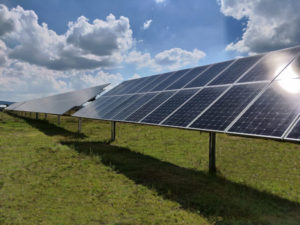Innovated procedure in solar trackers design

The structural international regulations are not sufficient to face the current aeroelastic phenomena. Nclave company provide a solution for this emptiness in the field of trackers design.
The innovative process incorporates several requirements to be fulfilled during trackers design, overcoming the deficiency dragged by international standards.
Designed by the photovoltaic company Nclave, this method includes an update which considers the structures behavior in front of dynamic effects as flutter or torsional galloping, which were not taken as relevant until now. Its application has developed, as a result, the new single row tracker SP 160 2V.
It is a fact, that the structural international regulations are insufficient to guarantee the solar trackers integrity while facing aeroelastic phenomena due to wind blow. The new challenges of this industry, going all the way through the maximum optimization of the resources to manage to reduce the LCOE, have led to much bigger trackers than their predecessor. This new reality implies a challenge that neither ASCE nor EUROCODE contemplated within enough consideration.
BACKGROUND, PROBLEMS OF AEROELASTIC INSTABILITY
As well as it happened to the engineers responsible of the design of Tacoma bridge, the optimization in the structures design and the use of new and far more resistant materials have led to slender structures. The static design is not the key factor in structural calculation anymore, making aerodynamic phenomena as flutter critical aspects that condition the tracker design.
Flutter or torsional galloping are aeroelastic non-stationery instabilities. These complex phenomena imply the alternate detachment of vortexes in the back and top sides of the photovoltaic module due to its oscillation.
STUDY OF DYNAMIC BEHAVIOUR
Due to these issues, Nclave detected the need to fulfill several researches to reframe the single row tracker design SP160 2V. Among different analysis, there is the study of aeroelastic wind tunnel, whereby the critical wind speed in which the tracker suffers flutter was calculated. In this study, 62 different configurations were analyzed. One of the main conclusions obtained from this study was that, staying in horizontal position, the critical speed is higher than in the rest of tested positions.
Through CFD analysis and the provisional FEM, the reduction of wind speed between rows and the increase of tension in the tracker due to flutter was evaluated. The conclusion was the existence of an important reduction in the wind impact due to the rows effect.
Combining these studies and tests results with the measurement of the tracker dynamic parameters in an experimental modal test, it is evaluated if it could suffer an aeroelastic instability. This evaluation allows the individualized study per project according to the design speed.
In short, this analysis of structural design, validated by first level engineering, manages to solve the implicit deficiencies of the regulations and offers a solution to the singularities of dynamic behavior in this type of structures.
Nclave manage to keep leading in the design and manufacturing of photovoltaic solar trackers in any configuration, and under any type of request.


 en
en Español
Español 日本語
日本語 中文
中文